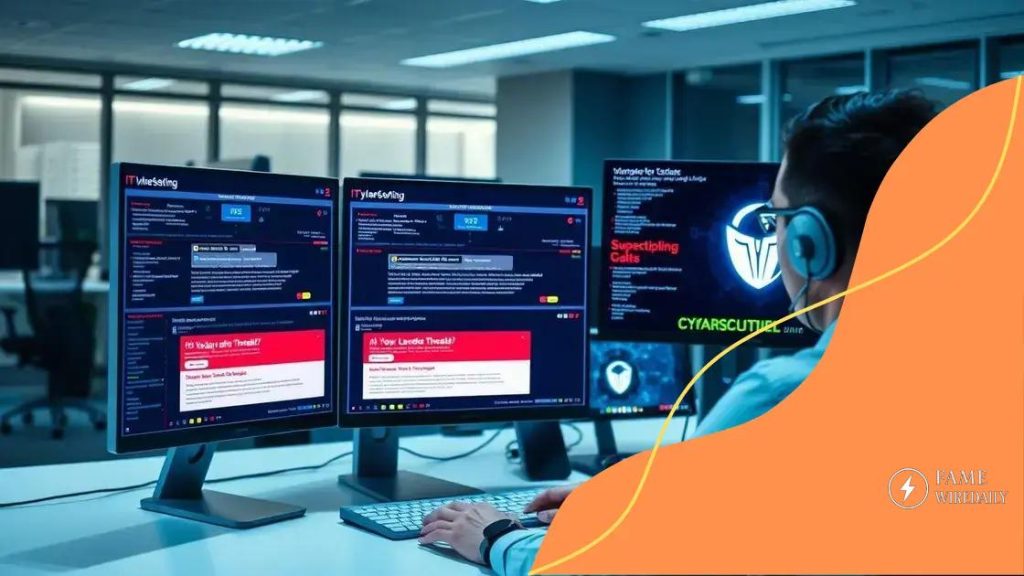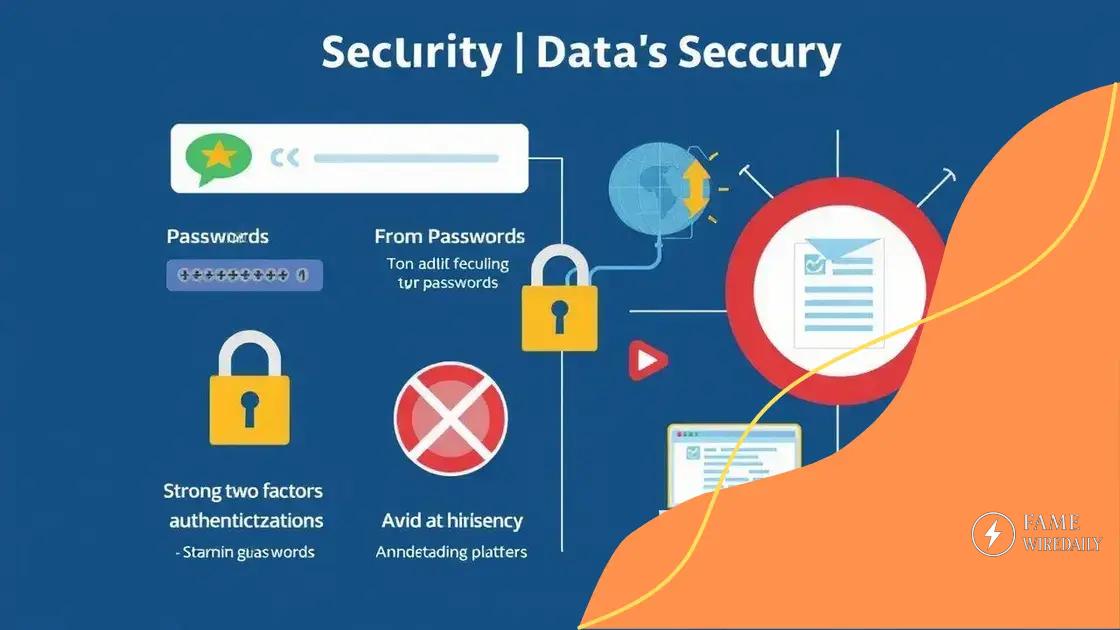Cybersecurity threats escalate: protect your data now

Anúncios
Cybersecurity threats escalate as technology advances, making it essential for individuals and organizations to implement strong defenses such as AI solutions, zero trust models, and continuous education to protect sensitive information.
Cybersecurity threats escalate every year, and it’s more important than ever to stay informed. With data breaches and attacks rising, how can we keep our information safe? In this article, we’ll delve into the current challenges and offer tips to enhance your security.
Anúncios
Understanding the landscape of cybersecurity threats
Understanding the landscape of cybersecurity threats is essential in today’s digital age. As our reliance on technology grows, so too does the need to protect our sensitive information. Various types of threats can compromise our data, and recognizing these is the first step to safeguarding it.
Types of Cybersecurity Threats
There are several key categories of cybersecurity threats to be aware of:
- Malware: This includes viruses, worms, and ransomware that can damage systems and steal information.
- Phishing: Attackers use deceptive emails or messages to trick users into revealing personal information.
- Insider threats: Employees or contractors who misuse access to sensitive data can pose significant risks.
- DDoS attacks: Distributed Denial of Service attacks can overwhelm systems, making them unavailable to users.
Each of these threats exploits different vulnerabilities, and understanding them helps in developing effective defenses. Staying informed about emerging threats can further enhance your cybersecurity strategy.
Anúncios
Importance of Regular Updates
One vital aspect of cybersecurity is ensuring your software and systems are regularly updated. These updates often include patches that fix vulnerabilities. By neglecting to perform these updates, you risk leaving your systems exposed to attackers looking for outdated software. Additionally, training employees on recognizing phishing attempts is crucial. Organizations should conduct regular awareness sessions to help staff identify and report suspicious communications.
While it may seem overwhelming, navigating the landscape of cybersecurity threats is manageable. By focusing on education, regular updates, and a proactive approach, both individuals and organizations can significantly reduce their risk of falling victim to cyber attacks.
Common types of cyber attacks and their impact
Common types of cyber attacks can significantly impact individuals and organizations. By understanding these threats, you can better prepare yourself and your systems against potential harm. Many attacks result in data loss, financial theft, and reputational damage.
1. Ransomware
Ransomware is a specific type of malware that encrypts a victim’s files, demanding payment for the decryption key. This attack can lead to severe business disruptions. Organizations often face hefty costs beyond the ransom itself, including downtime and recovery efforts.
2. Phishing
Phishing attacks often come through email. Cybercriminals impersonate trustworthy entities to steal sensitive information like passwords and credit card numbers. It’s crucial to recognize warning signs.
- Check for misspellings or unusual email addresses.
- Be wary of urgent requests for personal information.
- Hover over links to see the actual URL before clicking.
- Never open attachments from unknown sources.
These precautions can greatly minimize the risk of falling victim to such scams. Phishing remains one of the most common and effective attack methods because it exploits human psychology.
3. DDoS Attacks
A Distributed Denial of Service (DDoS) attack overwhelms a server with traffic, making it unresponsive to legitimate users. These attacks often target websites and can result in lost revenue and frustrated customers. The impact is not just about downtime; it can also damage reputation.
4. Man-in-the-Middle Attacks
In a Man-in-the-Middle attack, the attacker secretly relays and possibly alters communications between two parties. This can happen over public Wi-Fi networks where attackers intercept data. Using a VPN can help protect against this type of threat.
By knowing about these common cyber attacks, individuals and organizations can better protect themselves. Awareness is the first step in building strong defenses against the ever-evolving world of cyber threats.
Strategies to secure your personal data

Securing your personal data is vital in our increasingly digital world. By implementing effective strategies, you can protect yourself from potential threats and keep your information safe. Simple practices can significantly enhance your security posture.
Use Strong Passwords
A strong password is your first line of defense. It should be at least 12 characters long and include a mix of uppercase letters, lowercase letters, numbers, and special symbols. Avoid using easily guessed information like birthdays or common words. Consider using a password manager to help generate and store complex passwords securely.
Enable Two-Factor Authentication
Using two-factor authentication (2FA) provides an additional layer of security. Even if someone manages to obtain your password, they will still need a second piece of information, such as a code sent to your phone, to access your account. This makes it significantly harder for unauthorized users to gain access.
- Enable 2FA on all accounts that offer it.
- Choose authentication methods that are secure and reliable.
- Regularly update your authentication settings.
- Keep your phone secure, as it is part of your 2FA system.
By taking these measures, you reduce your risk of falling victim to cyber attacks. Keeping your software updated is another essential practice. Regular updates often include security patches that address vulnerabilities.
Be Wary of Phishing Attacks
Educating yourself about phishing tactics can help protect your data. Phishing attempts frequently come via email or messages, tricking you into revealing personal information. Look out for suspicious links, and verify the sender’s identity before clicking on any links.
Finally, always back up your data regularly. Use secure cloud storage or external hard drives to keep your critical information safe. If you experience a data loss incident, having a backup can save you from significant troubles.
The role of technology in fighting cyber threats
The role of technology in fighting cyber threats is crucial for organizations of all sizes. Advanced tools and systems can help detect, prevent, and respond to attacks effectively. As threats evolve, so must our technology solutions.
1. Firewalls
Firewalls act as a barrier between a trusted internal network and untrusted external networks. They monitor incoming and outgoing traffic and can block suspicious activity. Firewalls are essential for creating a strong defense against cyber threats.
2. Intrusion Detection Systems (IDS)
An Intrusion Detection System helps in identifying potential threats by analyzing network traffic for unusual patterns. When suspicious activity is detected, alerts are generated for further investigation. This proactive approach enables faster responses to threats.
- Monitor user activities in real-time.
- Identify patterns that indicate breaches.
- Help organizations comply with security regulations.
Combining IDS with other security measures creates a comprehensive security strategy.
3. Antivirus Software
Antivirus software defends against malware by scanning incoming files and monitoring system behavior. Regular updates to the antivirus database are vital since new threats emerge daily. This software provides a fundamental layer of protection for all computer systems.
4. Security Information and Event Management (SIEM)
SIEM solutions collect and analyze security data from various sources. They provide real-time analysis, helping organizations detect and respond to incidents quickly. SIEMs integrate with other technologies, ensuring a thorough overview of an organization’s security posture.
Technology plays an essential role in strengthening defenses against cyber threats. Utilizing advanced tools is not just beneficial; it’s necessary. Investing in the right solutions will enhance data protection and improve the overall security infrastructure.
Future trends in cybersecurity and what to expect
Future trends in cybersecurity are rapidly evolving as technology advances and cyber threats become more sophisticated. Businesses and individuals must stay informed and adaptive to protect their sensitive information effectively. Understanding upcoming trends can help in preparing for potential challenges.
1. Artificial Intelligence (AI) and Machine Learning
AI and machine learning play an increasing role in cybersecurity by analyzing vast amounts of data to detect anomalies and predict threats. These technologies can automate responses to attacks, reducing response times and improving overall security.
2. Zero Trust Security Models
The zero trust model requires strict verification for every user and device attempting to access the network. Trust is never assumed, regardless of where the request originates. This approach ensures that even if a breach occurs, the damage is limited.
- Continuous monitoring of user activity.
- Strict access controls based on user roles.
- Regularly updated security protocols.
Implementing a zero trust model can significantly enhance an organization’s security posture.
3. Cloud Security Innovations
As more companies shift to cloud-based services, cloud security will become even more critical. New tools and technologies are being developed to protect sensitive data stored in the cloud. Strong encryption methods and comprehensive access controls will be essential to safeguard information.
4. Increased Focus on Data Privacy Regulations
With growing concerns about data privacy, governments worldwide are implementing stricter regulations. Organizations must comply with these regulations to avoid heavy fines and protect user data. Ensuring compliance will require investments in security infrastructure and employee training.
As we look to the future, staying ahead of these trends is crucial. Organizations that proactively adopt new technologies and practices will be better positioned to defend against evolving cyber threats.
FAQ – Frequently Asked Questions about Cybersecurity
What are the most common types of cyber threats?
The most common types of cyber threats include ransomware, phishing, malware, and DDoS attacks. Each poses unique risks to personal and organizational data.
How can I strengthen my cybersecurity defenses?
To strengthen your defenses, use strong passwords, enable two-factor authentication, keep your software updated, and educate yourself about phishing tactics.
Why is investing in cybersecurity important?
Investing in cybersecurity is essential to protect sensitive information, comply with regulations, and maintain trust with customers and stakeholders.
What role does AI play in cybersecurity?
AI helps in cybersecurity by enhancing threat detection, automating responses to attacks, and analyzing large data sets to identify anomalies quickly.





